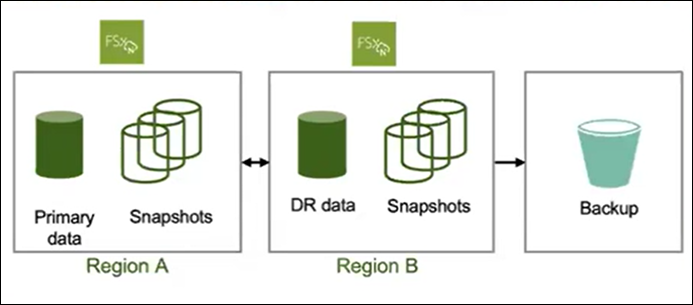Types of data protection in NetApp Workload Factory
 Suggest changes
Suggest changes


FSx for ONTAP supports snapshots, NetApp Autonomous Ransomware Protection with AI, replication, and backups for data protection. We recommend that you use a combination of data protection types to prepare for the inevitable and safeguard your data.
Types of data protection
Data protection for your workloads helps ensure that you can recover from any data loss at any time. Learn about the types of data protection before you select the features you'll use.
A snapshot creates a read-only, point-in-time image of a volume within the source volume as a snapshot copy. You can use the snapshot copy to recover individual files, or to restore the entire contents of a volume. Snapshots are the basis of all the backup methods. The snapshot copy that is created on your volume is used to keep the replicated volume and backup file synchronized with changes made to the source volume.
NetApp Autonomous Ransomware Protection with AI (ARP/AI) uses workload analysis in NAS (NFS/SMB) environments to detect and warn about abnormal activity that might be a ransomware attack. When an attack is suspected, ARP/AI also creates new, immutable snapshots in addition to the existing protection provided by scheduled snapshots.
Replication creates a secondary copy of your data on another FSx for ONTAP file system and continually updates the secondary data. Your data is kept current and remains available whenever you need it, such as for disaster recovery.
You can choose to create both replicated volumes on another FSx for ONTAP file system and backup files in the cloud. Or you can choose just to create replicated volumes or backup files - it's your choice.
You can create backups of your data to the cloud for protection and for long-term retention purposes. If necessary, you can restore a volume, folder, or individual files from the backup to the same, or different, working file system.
The following diagram shows a visual representation of data protection for FSx for ONTAP storage using snapshots, replication across regions, and backup to object storage.

Best practices for protecting your workload data
FSx for ONTAP offers multiple data protection options which can be combined to achieve your selected recovery point and time objectives. For the best possible protection, we recommend that you use both volume snapshots and volume backups.
A recovery point objective (RPO) describes how recent the latest copy of your data is guaranteed to be, which depends on how frequently the copies are made. A recovery time objective (RTO) defines how long it takes to restore your data.
Protect your workload data with snapshots
Snapshots are virtual point-in-time versions of a volume that are taken on a scheduled basis. You can access snapshots using standard file system commands. Snapshots provide an RPO of as little as one hour. RTO depends on the amount of data to restore and is primarily limited by the volume throughput limit. Snapshots also allow users to restore specific files and directories, which decreases RTO even further. Snapshots only consume additional volume space for changes made to the volume.
Protect your workload data with NetApp Autonomous Ransomware Protection with AI
NetApp Autonomous Ransomware Protection with AI (ARP/AI) acts as an important additional layer of defense if anti-virus software has failed to detect an intrusion. Setting an ARP/AI policy enables it for all storage VMs and all existing and newly created volumes. Once enabled, ARP/AI detects and protects all volumes and storage VMs. If a file extension is flagged as abnormal, you should evaluate the alert.
Protect your workload data with volume replication
Volume replication creates a copy of the latest data of a volume including all its snapshots in a different region. If you cannot afford multi-hour RTOs of a full volume restore operation from a volume backup, consider performing a volume replication. While volume replication makes sure recent data is available in a different region for you to use, you need to adjust your clients to use the volume in the other region.
Protect your workload data with backups
Volume backups provide independent point-in-time copies of your volume. They can be used to store old backups and provide the necessary second copy of your data. Daily, weekly, and monthly backup schedules allow for RPOs starting at one day. Volume backups can only be restored as a whole. Creating a volume from a backup (RTO) can take hours to many days, depending on the size of the backup.
Recommendations for protecting your workload data
Consider the following recommendations for protecting your workload data.
-
Use volume replication for disaster recovery: if your application requires a low RTO, consider using volume replication to replicate your data to another region.
-
Use volume backups in conjunction with snapshots: using the two features together ensures that you're able to restore your files from snapshots and perform full restores in case of volume loss using backups.
-
Define a volume backup policy: make sure that the backup policy satisfies your company requirements for backup age and frequency. We recommend keeping a minimum of two daily backups for each volume.
-
Define a snapshot schedule: older snapshots are less likely to be used to restore data. We recommend that you define a snapshot schedule that takes into consideration the diminishing returns of keeping older snapshots against the cost for additional snapshot capacity.
-
Enable an ARP/AI policy for your file system or individual volumes to add an additional layer of protection to protect your data from ransomware attacks.


